Make them for their intense, fruity flavours, jewel-bright colours and the beauty of seeing them standing in rows on your larder shelf.
Elderberry Jelly with a Chilli Kick
Jane: There’s a sprawling elder bush just over the river
from us which has been dripping glistening black elderberries for the last
couple of weeks, desperate to be made into elderberry jelly. So finally we
obliged. But instead of spread-on-bread-jam I wanted to make something with a
kick, that you could eat with cold meats and cheese. Aha! Just add chilli!
Surprisingly, the kids loved this jelly, and what’s more it offers fantastic
protection against winter colds and flu – take a daily dose as soon as you feel
a sniffle coming on.
|
 |
|
Beetroot Chutney
Tamsin: This is the season when I seem to be peeling and chopping whenever I have a free moment in an attempt to preserve all that the garden is producing. I've made many different types of chutney in my time but this year's beetroot one is truly scrumptious - deemed so delicious by my husband that he immediately banned me from giving any of it away!
|
 |
|
Medlar Jelly
Jane: My neighbour has a rarity in his front garden – an exquisitely shaped medlar tree which produces prolific late-ripening winter fruit. You just shake its leaf-bare branches and a profusion of hard, yellowy-brown, inedible fruits hits you on the head. Inedible at least until they are made into jelly, cheese or ‘bletted’ – stored until they go brown and soft, internally fermenting (they look as if they are rotting) until the flesh turns to a fragrant, slightly cloying-tasting pulp. Given this, you can understand why medlars are not popular today, but they were considered a delicacy in Victorian times, the bletted fruit scooped out and eaten raw with cream and sugar as a winter pudding.
|
 |
|
Hedgerow Heaven
Jane: Last weekend the children were camping, so Mal and I went hedgerow picking with a step ladder. Ooh, it made life much easier. We could reach all the sloes and lovely juicy blackberries that everyone else had left behind. I’ve just bought a fantastic book, Hedgerow Medicine, which shows you how to make teas, tinctures and balms from the plants that are all around us. But I started off with hedgerow jelly:
|
 |
|
Herb Jelly
You don’t often come across herb jellies nowadays, but I love this one spread on oatcakes with a bite of cheese or cold meat on top. It’s also a bit different as a thank-you party gift at Christmas time.
|
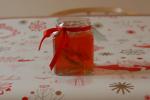 |
|
Apricot and Ginger Mincemeat
Home-made mincemeat is so full of gorgeous juicy flavour you won’t ever want to go back to bought. It’s also a doddle to make – just chop, mix and leave overnight.
|
 |
|
Rosehip Syrup
This brings back good memories: as kids we were given a spoonful a day in winter to boost our vitamin C levels and keep colds at bay. Rosehips are plentiful in October and November - we picked enough for this recipe in a half hour walk along the hedgerows. Pour the syrup over pancakes, waffles, ice cream and even rice pudding in place of maple syrup.
|
|
|
Spiced Quinces
In England, quinces were traditionally eaten with meats like game and pork, and these spiced quinces are delicious served with stews and casseroles. If you can’t find quinces, use slightly unripe pears instead.
|
 |
|
Bottled Fruit
An easy way to bring the jewelled glow and taste of summer fruit to your table in the dark months of winter. I always eat bottled raspberries at Christmas dinner instead of pud. Just strain some of the liquid off on Christmas morning and add sugar to taste. Then place the raspberries in a bowl and pour the sweetened juice over.
|
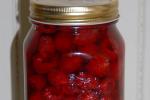 |
|
Quince and Ginger Jam
A rich and fruity paste that’s delicious spread on toast at breakfast. It makes a good Christmas gift too, if you dress up the jars with a bow and handwritten label.
|
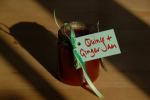 |
|
Membrillo/Quince Cheese
This thick, fruity paste is nothing to do with cheese – it’s solid quince (also known as membrillo) and has been a delicacy since medieval times. I always serve it at Christmas with Cabrales, a Spanish blue cheese which tastes a bit like Roquefort.
|
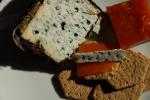 |
|
Christmas Already...
Tamsin: This weekend my mind began to turn to Christmas – early I know but there is one family tradition which needs to be thought about now. It’s the Christmas pud. I’ve never been keen on the traditional kind, probably because dried fruits are not my favourite (something to do with their texture). So instead my treat is a bowl of bottled raspberries – perhaps a unique Christmas dessert, though you never know?
I’d normally bottle our autumn raspberries which fruit from July to October but due to some upheavals in the fruit cage and rather weird weather, I’ve only managed to grow about 10 individual fruits this year. So instead, I’m bottling bought raspberries – which doesn’t feel like a letdown since the process is so easy and the end result so beautiful and satisfying. The fruit is preserved with all its original taste in a liquid that over time absorbs flavour and turns it into nectar.
|
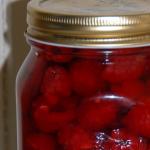 |
|
Sterilising Jars
Before you bottle jams or preserves, always sterilise the jars.
|
|
|
Jam's Setting Point
How to know when your jam has reached setting point:
|
|
|
Thank You Apricot Jam
Joe likes making this one as an end-of-year gift for his teachers, but it's kind of delicious for eating at home too.
|
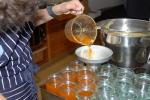 |
|